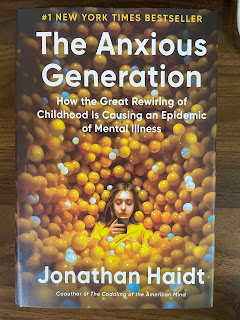The Anxious Generation
by Jonathan Haidt
This book is about the tragic great rewiring that was inflicted on Gen Z between 2010 and 2015 that completely upended them from a normal childhood and caused a generational mental health crisis. He presents more than a dozen mechanisms by which this enormous rewiring of childhood has interfered with children's social and neurological development, covering everything from sleep deprivation to attention fragmentation, addiction, loneliness, social contagion, social comparison, and perfectionism. He explains why social media damages girls more than boys and why boys have been withdrawing from the real world to the virtual world, with disastrous consequences for themselves, their families, and their societies.
Here are some pointers that I drew from this book:
The mental health crisis has hit boys and girls in a different manner. Their rates of depression and anxiety among boys have also increased a lot, although usually not by as much as for girls. Boys technology use and mental health difficulties are somewhat different from those of girls.
2. Between 2010 and 2015, the social lives of teens moved largely onto smartphones with continuous access to social media, online video games, and other internet-based activities. This Great Rewiring of Childhood, the author argues, is the single largest reason for the tidal wave of adolescent mental illness that began in the early 2010s.
3. Free play is as essential for developing social skills, like conflict resolution, as it is for developing physical skills. But play-based childhoods were replaced by phone-based childhoods as children and adolescents moved their social lives and free time onto internet-connected devices.
4. Children learn through play to connect, synchronise, and take turns. They enjoy attunement and need enormous quantities of it.
5. Attunement and synchrony bond pairs, groups, and whole communities. Social media, in contrast, is mostly asynchronous and performative. It inhibits attunement and leaves heavy users starving for social connection.
6. The human brain contains two subsystems that put it into two common modes: discover mode (for approaching opportunities) and defend mode (for defending against threats). Young people born after 1995 are more likely to be stuck in defend mode, compared to those born earlier. They are on permanent alert for threats rather than being hungry for new experiences. They are anxious.
7. All children are by nature antifragile, from the book Antifraglie by Nassim Nicholas Taleb. Just as the immune system must be exposed to germs and trees must be exposed to wind, children require exposure to setbacks, failures, shocks, and stumbles in order to develop strength and self-reliance. Overprotection interferes with this development and renders young people more likely to be fragile and fearful as adults.
8. Children are most likely to thrive when they have a play-based childhood in the real world. They are less likely to thrive when fearful parenting and a phone-based childhood deprive them of opportunities for growth.
9. Smartphones are a second kind of experience blocker. Once they enter a child's life, they push out or reduce all other forms of non-phone-based experience, which is the kind that their experience-expectant brains most need.
10. Dopamine release is pleasurable, but it does not trigger a feeling of satisfaction. Rather, it makes you want more of whatever you did to trigger the release. The addiction researcher Anna Lembke who authored Dopamine Nation, says that the universal symptoms of withdrawal are "anxiety, irritability, insomnia, and dysphoria." She and other researchers find that many adolescents have developed behavioral addictions that are very much like the way that people develop addictions to slot machine and gambling.
11. Social media harms girls more than boys. Correlational studies show that heavy users of social media have higher rates of depression and other disorders than light users or nonusers. The correlation is larger and clearer for girls: heavy users are three times as likely to be depressed as nonusers.
12. Girls use social media a lot more than boys, and they prefer visually orientated platforms such as Instagram and TikTok, which are worse for social comparison than primarily text-based platforms such as Reddit.
13. Two major categories of motivations are agency (the desire to stand out and have an effect on the world) and communion (the desire to connect and develop a sense of belonging). Boys and girls both want each of these, but there is a gender difference that emerges early in children's play: Boys choose more agency activities; girls choose more communion activities. Social media appeals to the desire for communion, but it often ends up frustrating it.
14. Girls are more sensitive to visual comparisons, especially when other people praise or criticize one's face and body. Visually orientated social media platforms that focus on images of oneself are ideally suited to pushing down a girl's "sociometer" (the internal gauge of where one stands in relation to others).
15. Girls are also more likely to develop "socially prescribed perfectionism," in which a person tries to live up to impossibly high standards held by others or by society.



No comments:
Post a Comment